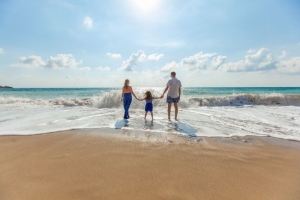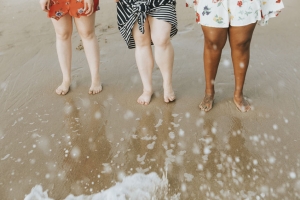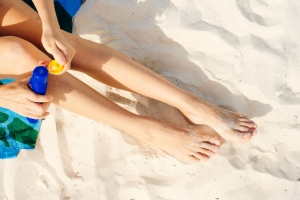Connect With Us
Blog
Displaying items by tag: summer foot care
Avoiding Podiatric Problems at the Beach
At Superior Foot & Ankle Care Center we know that our Los Angeles County patients are within driving distance of many beautiful California beaches. This favorite summertime excursion, however, can end in pain and discomfort for your feet or ankles if you fail to take the proper precautions. Below are some beach-day fun busters and how to prevent them.
Burns—while sunburn is an obvious concern that most people are aware of on a beach day, we find that many patients neglect to apply sunscreen diligently to their feet. It’s essential to use a water-resistant, broad-spectrum sunscreen that protects against both UVA and UVB rays with an SPF of at least 30. Be sure to apply the sunscreen to the tops and bottoms of your feet. Sitting in a sand chair the soles of your feet are exposed to direct sunlight and reflective rays off the sand. Reapply sunscreen to your feet after swimming or every two hours, whichever comes first.
Walking on hot sand or pavement can also cause the soles of your feet to burn. It may seem like a short trip to get to your beach blanket, but the temperatures of the sand can easily heat up enough to cause third-degree burns to the skin in a very short time. Always cover your feet before stepping out.
Jelly Fish Sting—Did you know that these creatures can still sting you even after they have washed up on the shore and died? Pack a small container of vinegar or baking soda in your beach bag and apply it to a jellyfish sting to relieve pain. Most stings will heal on their own within a few days. If yours appears to be getting worse instead of better, contact our Long Beach office at (562) 420-9800 office for an appointment so that our podiatrists, Dr. Victoria M. Foley and Dr. Constance Ornelas, can examine your wound and determine if it has become infected.
Ankle Sprain—some people enjoy adding a little sports activity to their beach day with a game of beach volleyball or frisbee. If you fall into this category, remember to bring sneakers to support your feet in sliding sands to avoid ankle sprains and other injuries.
Puncture Wound—sharp objects can easily be concealed in the sand. Wear shoes for beach walks to avoid cuts. If you do get a cut, clean it immediately and put antibacterial ointment and a bandage on the wound.
We hope you have lots of summer fun! If you have any foot or ankle issues, contact us for evaluation and treatment.
Avoid These 4 Podiatric Pitfalls on Vacation
At Superior Foot & Ankle Care Center we know many of our Los Angeles County patients can’t wait to take a vacation. After a year plus of Covid restrictions, you’ve got places to go and people to see! Our goal is to make sure a painful foot problem doesn’t slow you down. Below are four potential pitfalls you’ll want to avoid on your summer vacation.
- Not Wearing Socks with Sandals—Yes, you read that right. While normally wearing socks with sandals would be a fashion “faux pas,” if your trip starts with an airplane flight it’s highly encouraged. Most security checks require you to remove your shoes. Every person who walks with bare feet through the scanner machine has the potential to leave behind bacteria or fungi that can result in athlete’s foot, fungal toenails or another infection which are passed on by direct contact for the people who follow them.
- Getting New Shoes for Vacation—It’s great to find the perfect pair of shoes to go with your new shorts and sundresses, but packing them before wearing them can be a big mistake. Even though you should always try on both shoes when purchasing and spend some time in the store walking around, new shoes can still surprise you with blisters or rubbing in places you didn’t expect. Try them out at different times (your feet are largest and most swollen at the end of the day) for a day or two before you go to make sure they are comfortable and pain-free.
- Being a Bare-Foot Beach Bum—With the sun beating down on it, the sand at the beach can heat up to over 100 degrees F. Even a few steps from the parking area to your beach blanket can result in dangerous blistering burns to the soles of your feet. If you like to take walks on the beach, a pair of water shoes can also help you avoid sharp objects that can cause puncture wounds and other hazards like jellyfish that have washed up on the shore.
- Forgetting to Pack Foot Care Essentials—Even if you’re only traveling with a carry-on bag you should have room for a few small items that can make a big difference in foot comfort while on vacation. If our podiatrists, Victoria M. Foley and Dr. Constance Ornelas, have prescribed a custom orthotic, don’t leave it home! It’s also a good idea to bring moleskin to prevent painful blisters, foot powder, nail clippers, and an emery board.
We hope you and your family have a great vacation this summer. If you find a foot or ankle is hurting you when you return, or you notice other unusual symptoms in your feet, be sure to contact our Long Beach office at (562) 420-9800 office promptly for an appointment.
Take Steps to Prevent Skin Cancer This Summer
At Superior Foot & Ankle Care Center we know that our Los Angeles County patients enjoy the sun nearly year-round, but May is Skin Cancer Awareness Month and a good time to emphasize the importance of protecting your skin from the harmful effects of UV rays.
Research shows that currently one in five people will develop some form of skin cancer by the age of 70. In fact, there are more cases of skin cancer diagnosed each year than all other cancers combined. But skin cancer is also highly treatable and has a very high rate of survival when detected early. Below are steps you can take to lower your risk for this potentially deadly disease.
Be on the Lookout—one big advantage of skin cancer over other carcinomas is that you can see it. Commit to inspecting the skin on your feet and the rest of your body monthly. The Skin Cancer Foundation suggests that you lookout for:
- New—blemishes, freckles or moles that have appeared that weren’t present before
- Changing—growing larger, losing their borders, becoming mottled or containing new colors could all signal a potential cancer
- Unusual—any mark on your skin that bleeds, crusts over or is itchy or sore for more than three weeks
When it comes to your feet, be sure to look at the tops and the soles of your feet and between each toe. Look for spots on your nails or in the skin under the nail as well. If you see anything you’re concerned about, contact our Long Beach office at (562) 420-9800 to schedule an appointment with our podiatrists, Dr. Victoria M. Foley and Dr. Constance Ornelas, promptly.
Take Cover—seek shade during the hottest hours of 10 a.m. – 4 p.m. If you spend a large amount of time in the sun or are extra fair, freckled or have other issues that increase your risk for skin cancer consider shirts, hats and other clothing made with UPF (ultraviolet protection factor).
Be Generous with the Sunscreen—many patients often skip their feet when applying sunscreen but it’s just as essential there as any exposed skin. And not just when you are at the beach or pool. If you’re wearing open sandals for a day of shopping or running errands be sure to apply a broad-spectrum sunscreen with an SPF of 15 or higher about 30 minutes before going out. If you’re playing sports or swimming, choose a water-resistant variety and reapply after coming out of the water or every two hours.
Say No to Tanning Beds—these increase your risk for all types of skin cancer including dangerous melanomas by up to 75%. Even one time can increase your risk. Don’t let teens use tanning beds ever.
You can decrease your risk of skin cancer. If you have any questions about this disease and your feet, don’t hesitate to contact us.
Archives
Categories
- Featured (164)
- Blog (177)
- Ankle Care (6)
- Ankle Condition (2)
- Ankle Pain (0)
- Appointment Tips (2)
- Arch Pain (1)
- Arthritis (10)
- Athlete's Foot (6)
- Blister (1)
- Bunions (7)
- Calluses (1)
- Child Care (2)
- Circulation (1)
- Common Foot Conditions (4)
- Common Foot Problems (3)
- Corns (0)
- Custom Orthotics (1)
- Diabetes (10)
- Diabetic Foot Care (3)
- Diabetic Footwear (1)
- Edema (1)
- Exercise (4)
- Fall Prevention (1)
- Fitness (1)
- Flat Feet (2)
- Foot Care (19)
- Foot Care Safety Tips (3)
- Foot Care Tips (20)
- Foot Conditions (12)
- Foot Facts (3)
- Foot Health (6)
- Foot Odor (1)
- Foot Pain (5)
- Foot Problems (2)
- Foot Safety (1)
- Foot Surgery Tips (2)
- Foot Warts (2)
- Foot Wear (2)
- Fractures (1)
- Fungal Infection (2)
- General Health (0)
- Gout (5)
- Gout Treatment (0)
- Hammertoe (1)
- Health Tips (46)
- Heart Health (1)
- Heel Pain (0)
- Heel Spurs (0)
- Ingrown Toenails (4)
- Interesting Facts (2)
- Joint Pain (2)
- Leg Conditions (2)
- Leg Condtions (0)
- Men's Foot Health (1)
- Metatarsals (0)
- Nail Fungus (2)
- Neuropathy (1)
- Nutrition (2)
- Obesity (2)
- Osteoporosis (1)
- Pain Relief (5)
- Patient Communications (1)
- Pediatric Foot Conditions (5)
- Pediatric Foot Pain (2)
- Pedicure (1)
- Peripheral Arterial Disease (1)
- Plantar Fasciitis (2)
- Podiatrist Appointment (0)
- Pregnancy Feet (3)
- Proper Shoes (2)
- Senior Foot Care (7)
- Shoe Fit (1)
- Skin Cancer (3)
- Sports Injuries (2)
- Spring Foot Health (1)
- Summer Foot Health (2)
- Toe Pain (4)
- Uncategorized (5)
- Varicose Veins (2)
- Walking (1)
- Women Foot Health (3)
- Youth Sports (2)



